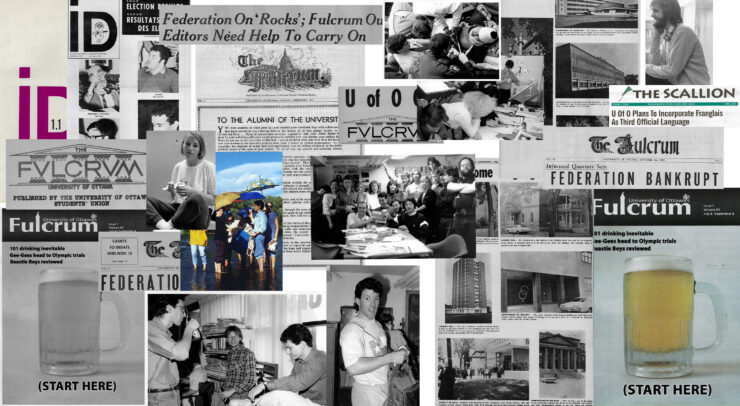A short history of the Fulcrum
The Fulcrum was officially launched as the University of Ottawa’s English-language student newspaper in 1942 and has published uninterrupted (save a year-long hiatus in the late 60s, which we’ll get to) since. Even more interestingly, the roots of the English-language student publication on campus go back much deeper than the 1940s. Based on numerous trips to the U of O’s archives and interviews with alumni, this is the unofficial history of the Fulcrum.
1888: Roots of the Fulcrum in the Owl
Decades before either The Fulcrum or La Rotonde were formed, the first English language student media outlet on the U of O campus was The Owl, a monthly journal formed in 1888.
“(The Owl) comes not as a prognosticator to penetrate into the dim future: nor even owl-like, to fly in the dark,” the paper’s first “Salutatory” reads. “No: its aim is clear — to unite more closely, if such a thing be possible, the students of the past and present to their Alma Mater by furnishing them with short and we hope interesting accounts of her progress in every line.”
The Owl featured a mix of school news, essays, short stories, poems and reviews. Oddly enough, the final edition of The Owl showed no sign of the journal slowing down.
“Kindly notice that this issue completes our eleventh volume. And — to quote Shakespeare — The Owl, though slightly disfigured, is still in the ring,” the editors wrote. It’s unclear exactly what led to The Owl’s demise.
1898: The University of Ottawa Review replaces The Owl
The Owl was eventually replaced by The University of Ottawa Review in 1898.
“The Ottawa University Review is the organ of the students,” the eight editors of the first edition wrote. “Its object is to aid the students in their literary development, to chronicle their doings-in and out of class, and to unite more closely to their Alma Mater students of the past and the present.”
The first edition of The Review included a collection of poems, a short story, a collection of editorials (“Explanatory,” “Self-Laudatory,” “Valedictory: Salutatory,” and “Informatory”), notable events that took place that month (“Assassination of the Empress of Austria”) a short section on school news, reviews of magazine articles and book, and a collection of local, alumni, and athletics news. Readers could subscribe to 10 editions of the paper for $1, while single copies of the paper went for 15 cents. The Review ceased publishing in June of 1915 due to a drop in the Anglophone student population, the U of O’s former chief archivist Michel Prévost wrote in 1992.
“To those who are laying down the editorial pen to go out into the great world and fight life’s battle we wish Godspeed and every success,” The Review’s last editorial reads, titled “Ave Atque Vale” (“Hail and Farewell”).
1926: The U of O’s first bilingual publication, the V.A.R., debuts
The U of O’s first bilingual student newspaper, The V.A.R., debuted in 1926 and published until 1928. The V.A.R. published a mixture of essays, poems and short stories, university and local news, as well as sports coverage. French and English content was not incorporated together but published in separate papers at the same time. Interestingly, the French and English versions contained mainly different content.
“This is Radio Station V-A-R broadcasting from the Philosopher’s quarters,” the front page of the first English edition reads, from November 1926. “Now take your hands right off the dials and sit back comfy in the old arm chair for you’ve just tuned in on one of the snappiest little radio stations this side of Hull.”
Essentially, the “tabloid” was meant to “throw a little variety into the dull routine of our existence.”
1942: The Fulcrum debuts
The Fulcrum hit newsstands for the first time in February of 1942, founded by the English Debating and Dramatic Society and led by Lorenzo Danis, who went on to launch the U of O’s Faculty of Medicine.
“It is our hope that the Fulcrum will accomplish credibly the mission suggested by the definition of the word ‘Fulcrum’, ‘that by which influence is brought to bear,’” John Beahen, the paper’s first editor, wrote.
Beahen later went on to become a Catholic bishop and was accused of both sexual abuse and sweeping sexual abuse allegations under the rug. He died in 1988.
The Fulcrum was published eight times throughout the academic year and initially was only funded through alumni donations. In 1943 the Fulcrum turned to advertising for funding.
1946: English Students Association takes over the Fulcrum
The English Students Association, a federated body of the Student Federation of the University of Ottawa (SFUO), took over the Fulcrum, the origins of the Fulcrum’s relationship with the SFUO that lasted until mid-2005.
1951: The Fulcrum survives a potential merger with La Rotonde
“Informed Quarters Say: Federation Bankrupt,” the Fulcrum’s frontpage headline read in October of 1951, detailing a debt of $3,000 for the SFUO, equivalent to just over $67,000 today.
“The next few days will be decisive,” the editors wrote.
One potential cost-saving measure on the table was the merging of the Fulcrum and La Rotonde under the name “The Ottawa.” The crisis was averted by the Fulcrum’s then editor-in-chief, Philip Nicolaides, who argued doing so would cause confusion and wouldn’t necessarily save cost, the Fulcrum wrote in November of 1951.
The two papers did begin sharing office space at the new “student house,” located at 609 Cumberland Street, which is now near the site of Café Nostalgica.
1963: The Fulcrum publishes weekly
The last issue of the Fulcrum in the 1962-1963 academic year brought along one of the paper’s numerous redesigns and reconfigurations, but also something the editors of neither the Fulcrum or La Rotonde had attempted thus far, according to the Fulcrum’s editors for the following year: a weekly publication cycle. The editors, in their September 1963 editorial, weren’t blunt about the fact that this wouldn’t be an easy task.
“Needless to say, such an undertaking will require a large and efficient staff,” they wrote. “Accordingly, we strongly urge everyone …. all those all those who wish to have some experience in this line, to drop around the offices of the Fulcrum as soon as possible.”
1964: The Fulcrum becomes more outspoken
Historically, the Fulcrum was a moderate newspaper up until the 1960s, according to Prévost.
“It did not play an advocacy role and, unlike (La Rotonde), it never had a strained relationship with university authorities,” Prévost wrote, describing how three editors were fired in 1958 for publishing a report that the university didn’t agree with.
The 1960s marked a change in the Fulcrum’s coverage, according to Prévost, and can be highlighted by one editorial from October of 1964. The editors criticized the U of O’s move to remove part of an issue of La Rotonde that the administration did not agree with. According to Prévost, the part of the issue in question was a piece criticizing the sight of Queen Elizabeth II in Quebec.
The Fulcrum placed blame on La Rotonde but more importantly on the U of O’s administration, a paradigm shift in the Fulcrum’s editorial voice and a foreshadowing to one of our major roles today: holding the university accountable.
“What the Fulcrum wants to know is why the Administration (sic) felt it was up to them to take the paper off the campus?”
1969: Meet ID Magazine
In 1969 the Fulcrum and La Rotonde shuttered their individual doors and joined forces to create a new student publication, ID Magazine, since “university papers were no longer managing to attract student interest,” Prévost wrote in his historical overview of both publications in 1992.
“ID Magazine is part of a new approach to campus communications initiated during the summer by the staffs of the now-defunct French and English tabloid newspapers,” the editors wrote in the first edition of ID, published in October 1969. “The magazine’s basic function is to serve (as) an opinion-making mechanism offering in-depth analysis of both academic and para-academic concerns.”
ID, like the V.A.R., didn’t run identical articles in both French and English but offered different articles for French and English readers, packaged into the same magazine.
1970: The Fulcrum returns
The Fulcrum made its return in September of 1970 with a tongue-in-cheek editorial. Ian Green, former editor-in-chief of ID, was at its helm.
“Like everything else at the students’ federation … we are operating on a threadbare budget,” the Fulcrum’s editors wrote, noting faculty associations were shouldering part of its costs and sending out a call for writers to contribute. “We will try our damndest to succeed, the rest is up to you.”
1988: Move to 631 King Edward Avenue
The Fulcrum moved to its current home at 631 King Edward Avenue from the University Centre (it’s unclear when the Fulcrum moved to the University Centre from Cumberland Street to begin with).
We’re “right around the corner from Father and Sons Restaurant (FNS), where we will most likely be if you can’t find us in our very convenient spot,” the editors wrote in September 1988, which still rings decidedly true.
2005: The Fulcrum goes independent
The fact that the Fulcrum was owned by the SFUO was always an intrinsic problem and a barrier to the newspaper doing its job properly, especially when it comes to editorial independence, according to Mary Cummins, Marcus McCann and Rob Fishbook, three Fulcrum alumni who negotiated the Fulcrum’s autonomy.
Independence from the SFUO was something that had been talked about within the Fulcrum for decades, but the final and conclusive push came with the summer issue of 2004, which the SFUO unsuccessfully tried to pull from stands. It featured a large and frosted mug of beer on the cover along with mentions of “frosh” throughout the issue (the SFUO preferred “101 week,” due to the negative connotations).
And while the Fulcrum was going through a very profitable period, much of the extra revenue was used to subsidize other parts of the SFUO — preventing the paper from growing, according to Rob Fishbook, who was news editor at the time.
As a result, the team worked with then-SFUO president Philip Lalibertié, who the editors say was very open to the idea of autonomy, through the 2004-05 academic year. Ownership of the Fulcrum officially transferred to the Fulcrum Publishing Society (also known as our board of directors) in June of 2005.
2015: The Fulcrum hosts NASH 77
The Fulcrum hosted NASH 77, the annual Canadian University Press student journalism conference. The yearly theme was “access,” with a goal of educating “students about the role of the modern journalist in relation to the access they may or may not have,” noting “access is fundamentally what journalists seek today.”
Peter Mansbridge, Diana Swaine, and Selena Ross spoke at the conference, to name a few journalists. The Fulcrum also hosted NASH 70 in 2008.
2018-19: The Fulcrum begins to transition away from print
This year the Fulcrum began printing only one special issue a month rather than publishing in print weekly, while continuing to publish online weekly with a revamped website.
2019-20: The Fulcrum goes online only
Come the 2019-20 academic year, the Fulcrum will transition exclusively to our website, making this our final print issue.
And now, a final word from our current editor-in-chief, Anchal Sharma:
The 2018-19 publishing year has been a long one here at the Fulcrum, from navigating dissolving student unions, to the Ford government’s ongoing cuts to education, not to mention a huge learning curve for the Fulcrum going digital.
Returning to our roots from 1942, we published eight print issues this year, with online content in between. The loss of weekly print issues was an emotional one, but a necessary one, and allowed us to cover a wider range of stories with more frequency.
This year was an experimental year for online, and we enjoyed the leisure of being more flexible with story deadlines, had the opportunity to conduct more investigative research, publish weekly videos, and run social media contests.
With an online-only news cycle in the coming academic year, students can expect a lot more from their publication.
Look out for live-streaming on our social media platforms like Instagram, Twitter, and Facebook, more video content, live-tweeting, and photo stories.
We also plan on implementing more multimedia to our articles, so if you like Buzzfeed quizzes, and memes, or the Economist’s timeline’s and graphs, you’ll like ours even better.
Seventy-seven years of print have offered students a lot in terms of building relationships, memories, and breaking memorable stories. While our transition is bittersweet, with an online platform, we hope to achieve even more.
While we will no longer occupy stands on campus, we will remain alive in the hearts and minds of our readers (and on www.thefulcrum.ca).





